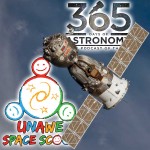Podcaster: Richard Drumm
 Title: Space Scoop: Rollercoaster Ride Back to Earth
Title: Space Scoop: Rollercoaster Ride Back to Earth
Organization: Astrosphere New Media
Link : astrosphere.org ; http://unawe.org/kids/unawe1447/
Description: Space scoop, news for children.
Bio: Richard Drumm is President of the Charlottesville Astronomical Society and President of 3D – Drumm Digital Design, a video production company with clients such as Kodak, Xerox and GlaxoSmithKline Pharmaceuticals. He was an observer with the UVa Parallax Program at McCormick Observatory in 1981 & 1982. He has found that his greatest passion in life is public outreach astronomy and he pursues it at every opportunity.
Today’s sponsor: This episode of “365 Days of Astronomy” is sponsored by — no one. We still need sponsors for many days in 2013, so please consider sponsoring a day or two. Just click on the “Donate” button on the lower left side of this webpage, or contact us at signup@365daysofastronomy.org.
Transcript:
This is 365 Days of Astronomy. Today we bring you a new episode in our Space Scoop series. This show is produced in collaboration with Universe Awareness, a program that strives to inspire every child with our wonderful cosmos.
Today’s story is…
Rollercoaster Ride Back to Earth
Early on the morning of November 10th, three astronauts, ESA’s Alexander Gerst, Russian Commander Maxim Suraev and NASA astronaut Reid Wiseman strapped into the Soyuz TMA-13M spacecraft, undocked from the International Space Station’s Rassvet research module (that’s Russian for dawn by the way) and plunged back to Earth.
Their fiery descent lasted 3-hours and they landed safely on the grassy Kazakh plains of central Asia, ending their 6-month mission in space.
Highlights of Gerst’s ‘Blue Dot’ mission included installing ESA’s furnace that can suspend and cool molten metal in mid-air, a spacewalk to maintain and improve the Space Station, and the docking of ATV Georges Lemaître Europe’s 5th and last ATV, Automated Transfer Vehicle – the largest spacecraft to supply the ISS.
You might think the hardest part of a mission to space is the launch, but landing offers its own kind of challenge. The Soyuz spacecraft begins plummeting to Earth at almost 30,000 kilometres per hour. (That’s 100 times faster than the fastest train!) To return the men home safely, this speed needs to be greatly reduced before they hit the ground.
The return to Earth is like riding a rollercoaster, becoming bumpier as they hit Earth’s atmosphere. At this point, all parts of the spaceship that are no longer necessary are ejected and burn up before reaching the ground.
Fifteen minutes before landing, parachutes will open, dramatically reducing the speed to a walking pace. Then, just one second before touchdown, six rockets will fire into life for a dramatic but safe landing.
Having landed successfully, their flight is over but their mission still has some way to go. An astronaut’s body adapts to living in space in many ways and they will be suffering from a loss of strength. Some have even had difficulty turning corners and walking in a straight line during the weeks after their return.
Learning to live with gravity again takes time and for weeks all returning astronauts, men and women alike, are watched by doctors as they readapt to life on earth.
ESA astronaut Alexander Gerst flew straight to the European Astronaut Centre, the home base for all ESA astronauts in Cologne, Germany. ESA’s medical team monitored how he readapted to gravity after spending more than five months in weightlessness!
Here’s a Cool Fact
At least one Soyuz is always attached to the space station. If there were an emergency on the space station, the crew could use the Soyuz to return safely to Earth.
Thank you for listening to 365 Days of Astronomy!
End of podcast:
365 Days of Astronomy
=====================
The 365 Days of Astronomy Podcast is produced by NUCLIO. Audio post-production by Richard Drumm. Bandwidth donated by libsyn.com and wizzard media. You may reproduce and distribute this audio for non-commercial purposes. Please consider supporting the podcast with a few dollars (or Euros!). Visit us on the web at 365DaysOfAstronomy.org or email us at info@365DaysOfAstronomy.org. This year we celebrate cosmic light as light is our info messenger in the universe. Join us and share your story to celebrate the International Year of Light. Until tomorrow! Goodbye!

